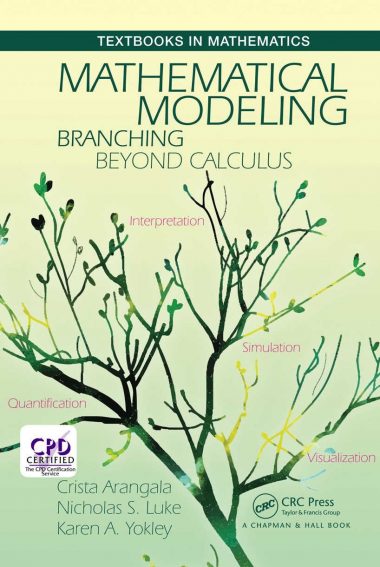The new book by Professor of Mathematics Crista Arangala and Associate Professor of Mathematics Karen Yokley of Elon along with Associate Professor of Mathematics Nicholas Luke of N.C. A&T State University is aimed at exposing a broad audience, including second- and third-year STEM students, to mathematical modeling.
Professor of Mathematics Crista Arangala and Associate Professor of Mathematics Karen Yokley of Elon along with Associate Professor of Mathematics Nicholas Luke of N.C. A&T State University have published a new book, "Mathematical Modeling: Branching Beyond Calculus," that focuses on exposing a broad audience to mathematical modeling. This textbook is aimed at second- and third-year STEM students and touches on a variety of topics including visualization, interpretation, optimization, simulation and differential equation modeling.
 “Mathematical Modeling: Branching Beyond Calculus” is designed to introduce mathematically-inclined students to modeling techniques and analysis as well as emphasize the need for discussing answers within the context of application. The textbook is designed to be flexible to the needs of different undergraduate mathematics programs by organizing topics based on prerequisite knowledge of the students. Each content section contains short exercises as well as projects, and each chapter ends with a “Chapter Synthesis” section including open-ended problems or exercises that direct students to revisit previous problems with different perspectives. These varying types of activities are intended to help students mature in their approaches and independence.
“Mathematical Modeling: Branching Beyond Calculus” is designed to introduce mathematically-inclined students to modeling techniques and analysis as well as emphasize the need for discussing answers within the context of application. The textbook is designed to be flexible to the needs of different undergraduate mathematics programs by organizing topics based on prerequisite knowledge of the students. Each content section contains short exercises as well as projects, and each chapter ends with a “Chapter Synthesis” section including open-ended problems or exercises that direct students to revisit previous problems with different perspectives. These varying types of activities are intended to help students mature in their approaches and independence.
Yokley was first inspired to write "Branching Beyond Calculus" while developing the course MTH 343: Mathematical Modeling at Elon. The course introduces mathematics and applied mathematics majors (as well as other mathematically-inclined students) to modeling techniques with various applications, and significant content in the book was created specifically for this course.
The book begins with a chapter entitled “Modeling Concepts, Visualization, and Interpretation” that includes a heavy emphasis on the articulation of results as well as understanding what those results mean in the context of the application. This emphasis was a result of Yokley’s experience teaching upper-level mathematics courses and realizing the foundational importance of interpretation. The first chapter of the book is accessible to students with a Calculus I background, and the textbook contains multiple activities that incorporate writing or discussion.
Additionally, Yokley is currently assisting the development of a website repository for educational modeling resources, the Math Modeling Hub, which is funded by the Consortium for Mathematics and its Applications (COMAP), National Council of Teachers of Mathematics (NCTM) and Society for Industrial and Applied Mathematics (SIAM).
Luke has taught various undergraduate mathematics courses, from college algebra to differential equations. His classroom expertise and experience designing class projects for students enrolled in the honor’s program at N.C. A&T have led to the book’s straightforward but entertaining approach to differential equation modeling. Luke has served as faculty mentor for several undergraduate and master’s-level students who have completed research projects involving differential equations modeling. Additionally, he served as the director of the 2015 N.C. A&T Biomathematics Institute Research Experience for Undergraduates. He currently serves as the coordinator of student success for the Department of Mathematics at N.C. A&T.
Arangala has taught MTH 343 multiple times, mostly after the course was updated to require a pre-requisite of MTH 231: Linear Algebra. Arangala has a passion for applying modeling techniques based in linear algebra and simulation to problems in a variety of fields. She has worked and published with undergraduates on multiple modeling projects, and many of the related applications are incorporated into this text. Arangala and Yokley also work with a research modeling team of students that focus on describing the spread of Dengue fever. Students on this team have focused on both differential and simulation models related to transmission, prevention and cost.
The research experiences of the three authors include using mathematics with several applications, such as toxicology, epidemiology, games, music genomics, advertising, folklore, acoustics, biomechanics and advertising. As a result, the textbook has problems related to various applications ranging from controlling elephant populations to designing ice cream cones.
“Mathematical Modeling: Branching Beyond Calculus” was published by CRC Press: Taylor & Francis Group in February 2018.


